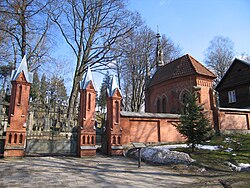Rossa Cemetery

Entrance to the cemetery.
|
|
| Details | |
|---|---|
| Established | 1769 |
| Location | Vilnius |
| Country | Lithuania |
| Type |
Public |
| Size | 10.8 hectares (27 acres) |
Public
Rasos Cemetery (Lithuanian: Rasų kapinės, Polish: cmentarz Na Rossie w Wilnie, Belarusian: Могілкі Росы) is the oldest and most famous cemetery in the city of Vilnius, Lithuania. It is named after the Rasos district where it is located. It is separated into two parts, the old and the new cemeteries, by a narrow Sukilėliai Street. The total area is 10.8 ha. Since 1990 new burials are allowed only to family graves.
The year 1769 is cited in many sources as the date when the cemetery was founded. However, some historians believe it is a typo and the real date should be 1796. On April 24, 1801 the new cemetery was consecrated. Two days later Jan Müller, the mayor of Vilnius, became the first person to be buried there. A formal document was signed in July 1801. It specified that the cemetery received 3.51 ha of land and that the cemetery will be free of charge to all city residents. It was the first cemetery in Vilnius not located next to a church.
In 1802-1807 two columbariums were built. They reached up to five stories in height and were joined at a right angle. At the end of the 19th century the columbariums began deteriorating. In between the columbariums, a neo-gothic red brick chapel was built in 1844–50. In 1888 a matching belltower was added to the chapel. At first the cemetery was surrounded by a wooden fence, but it burned down in 1812. A brick fence was rebuilt in 1820 and portions of it survive to this day.
In 1814 the cemetery was expanded as authorities bought additional land from a city resident. The addition is now known as the Hill of the Literaries (Lithuanian: Literatų kalnelis). In 1847, members of the Eastern Orthodox church opened their own cemetery next to Rasos. It was used to bury soldiers from a nearby monastery hospital and poor city residents. Therefore, it became known as the Cemetery of Orphans (Lithuanian: Našlaičių kapinės).
After World War II, the Soviet authorities demolished the right columbarium and in the 1970s razed the left columbarium. The whole necropolis was to be destroyed in the 1980s as the Soviet authorities planned a major motorway to be built directly through the cemetery. Due to a press campaign led by the Polish-language Czerwony Sztandar (Red Banner) newspaper and economic difficulties, the destruction was halted. After Lithuanian independence (1990) and the collapse of the Soviet Union (1991), Lithuanian and Polish authorities collaborated in a restoration of the cemetery.
...
Wikipedia
